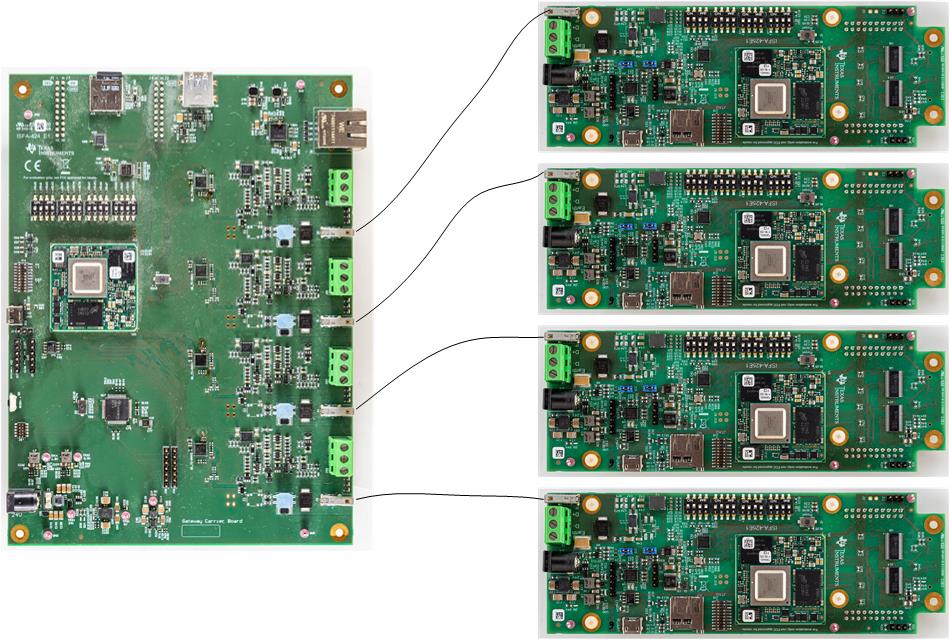SNVAA74 September 2023 AM2434 , AM6442 , DP83TD510E
Power over Dataline (PoDL), also called SPoE (Single-pair Power over Ethernet), combines single pair Ethernet (SPE) as well as power on one cable without the need of adding additional lines. 10 BASE-T1L, as standardized in IEEE 802.3cg, is gaining interest not only for factory automation, but also for building automation. This standard not only specifies the data communication, but also extends IEEE 802.3bu to define how PoDL is implemented.
PoDL (at a high-level view) has several similarities to well-known and established PoE (Power over Ehernet) as is used for standard Ethernet. However, the details are different. Both enable a method to add power to an Ethernet connection and also include mechanisms like detection and classification. These are needed to distinguish between a PoDL (or PoE) capable device from one that does not support this in a safe way. This can prevent damage to the connected device.
The way these are implemented is different. Where a PoE power sourcing equipment (PSE) determines classification by measuring the resistance of the connected powered device (PD), the PoDL PSE needs to see a Zener diode on the PD side. Classification is also implemented in a different way. PoE uses a simple analog implementation, whereas the PD behaves as a constant current sink in which the current defines the power class. PoDL has a digital slow speed data exchange between PSE and PD using the serial communication classification protocol (SCCP). In addition to these steps, a PoDL system also includes a pre-bias stage, that does not exist in PoE systems. For details on the implementation of a PSE, see the How to Implement an IEEE 802.3cg or 802.3bu-Compliant PoDL PSE application brief. The details of a PD are explained in the IEEE 802.3cg 10BASE-T1L Power over Data Lines Powered Device Design application note.
A complete PoDL system can be set up using the Four-port single-pair Ethernet with power over data line reference design and the 10BASE-T1L single-pair Ethernet sensor with power over data lines reference design.

Figure 1 TIDA-010262 (Left) and TIDA-010261 (Right)
For simplification, the block diagram in Figure 1 shows only the SPE and PoDL relevant blocks. The left side shows the PSE side (TIDA-010262), This design implements four ports with 10 BASE-T1L according to IEEE 802.3cg with support for PoDL including SCCP for classification. TIDA-010262 supports all 24 V power classes 10-12, up to 12 W with adjustable current limit. One MSPM0G1107 MCU is used for implementing the digital part of four ports including state machine handling and SCCP communication. Each port contains the analog parts of the PSE, an Ethernet PHY, and a coupling network (CDN) combining power and data. For additional information, refer to the Four-port single-pair Ethernet with power over data line reference design.
The right side shows the PD (TIDA-010261). This implements a corresponding PD, that supports power class 12. The SCCP communication is handled by a MSP430FR2476. Similar to the PSE side, a CDN separates power and data and feeds these accordingly to the PD circuit and the Ethernet PHY. For additional information, refer to the 10BASE-T1L single-pair Ethernet sensor with power over data lines reference design.

Figure 2 Implementation of a PoDL system for 10 BASE-T1L
The complete system shown in Figure 2 is an example implementation of a PoDL system for 10 BASE-T1L. These can be used not only in factory automation sensors or actuators, but also in building automation.
References
- Texas Instruments, How to Implement an IEEE 802.3cg or 802.3bu-Compliant PoDL PSE
- Texas Instruments, IEEE 802.3cg 10BASE-T1L Power over Data Lines Powered Device Design
- Texas Instruments, 10BASE-T1L single-pair Ethernet sensor with power over data lines reference design
- Texas Instruments, Four-port single-pair Ethernet with power over data line reference design
- Texas Instruments, MSP430FR2476